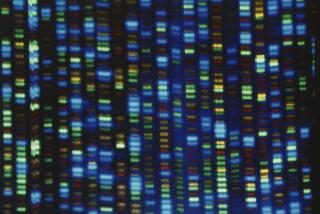Energy Dept. Close to Unlocking 3 Chromosomes’ Genetic Codes
- Share via
Marking another milestone on the way to deciphering the entire human genetic code, U.S. Department of Energy scientists announced Thursday that they have completed “working drafts” of three human chromosomes.
The 10,000 to 15,000 genes on these chromosomes include several known to be linked to serious diseases, including leukemia, high blood pressure, prostate cancer and diabetes. It is hoped that the detailed mapping of these genes will lead to new treatments for the disorders.
The entire human genetic code, called the human genome, is bundled up into small packages called chromosomes, which are present in virtually every cell in the body. The chromosomes, each with a distinctive size and shape, have been assigned the numbers 1 through 22 and the letters X and Y. (Females have two X chromosomes; males have one X and one Y.)
Running through the chromosomes are tightly coiled DNA molecules, which carry the genetic instructions needed for growth and maintenance of the human organism.
The Energy Department researchers, who are part of the publicly funded Human Genome Project, acknowledge that their “drafts” for chromosomes are not as complete as the finished code of chromosome 22, which was published in December.
The public effort’s working draft of the genome will include all 24 human chromosomes, including the three from the Energy Department, and is expected to be announced by summer.
Celera Genomics, a Maryland-based biotech company that is competing against the public effort, has said it will complete its version of the genome even sooner.
The announcement Thursday was intended to call attention to the role of the Energy Department in the public project, which was first suggested by a top department official 15 years ago. But the department has been overshadowed in recent years by the National Institutes of Health, which has taken the lead in the public effort, an international undertaking funded primarily by the U.S. government and Britain’s Wellcome Trust.
Energy Department scientists emphasized the usefulness of sequencing human and other animals’ genes in developing new treatments for human disease.
“We are in the incredible situation right now . . . of getting the instruction sets of lots of creatures, including ourselves,” said Elbert Branscomb, director of the Energy Department’s Joint Genome Institute. “We will have a reasonable opportunity to understand how they work and how to fix them. Up until now we have been struggling in the dark.”
Almost 15 years ago, Charles Delisi, then a top official at the Department of Energy, proposed an all-out, government-funded effort to decode the human genome--to read out, in order, the 3 billion occurrences of the four chemical building blocks of DNA, known as A, G, T and C. This sequence includes 100,000 or so genes that determine a variety of traits from eye and hair color to susceptibility to disease.
The department, which has its roots in the old Atomic Energy Commission, has had a long history of genetics research, conducted at first to assess the effects of radioactivity on workers building atomic weapons or nuclear power plants.
But as Delisi’s idea gained support, NIH and its National Genome Research Institute wound up with most of the funding. This year the Department of Energy has $89 million for its genetics research; NIH’s genome institute has $336 million.
The Energy Department operates one of the largest genome sequencing factories in the world in Walnut Creek, Calif. The Human Genome Project has divided up work on the chromosomes among different centers. The Energy Department researchers have sole responsibility for chromosomes 5, 16 and 19.
For each of the three, the scientists have finished 90% or more of the sequence, the accepted standard for a working draft, said Trevor Hawkins, director of sequencing at the department’s California facility.
Chromosome 5, the largest of the three, contains 194 million chemical letters and includes genes already linked to colon and skin cancers, leukemia, high blood pressure and one form of dwarfism. Chromosome 16, which is about half the size, has genes associated with breast and prostate cancers, Crohn’s disease and polycystic kidneys. The smallest of the three, chromosome 19, is home to genes that affect diabetes and hardening of the arteries.
Energy Secretary Bill Richardson said it is important to fund the public effort to the point of completion, “because we provide information every day to the public.” New sequences are posted daily on a public Web site called GenBank.
In contrast, Celera, which has completed the sequencing phase of its draft, has not released its data, except to its customers, which are primarily pharmaceutical and biotech companies.






